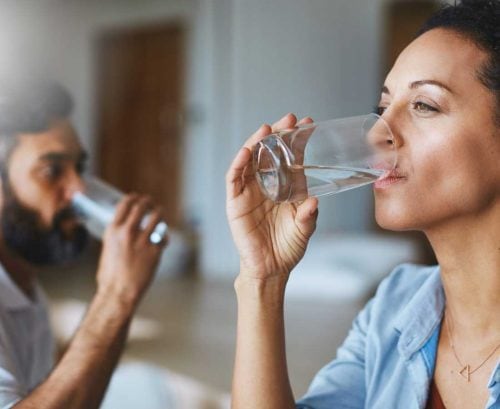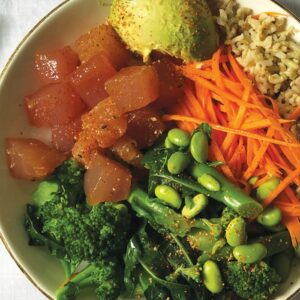
Feeling bloated, sluggish or moody? You could be dehydrated. Dietitian Melissa Meier decants some cool hydration tricks.
Let’s face it, drinking enough water can be a challenge — but as the temperature outdoors starts to soar, it becomes even more important. HFG dietitian, Melissa Meier, highlights some of the best ways you can up your H2O intake.
Every drop of water counts
Your body is made up of almost 80 per cent water — but here’s the catch. It can’t store water for later use, so you need to constantly replenish it. That’s why water is described as an essential nutrient.
Our bodies need water for multiple functions. It gives structure to cells, assists digestion and helps remove waste. It also plays a role in helping ensure our bloodstream stays fluid, as well as keeping our joints healthy. Plus, water is key for regulating our body temperature.
Despite the very important role of water, the average person’s intake is just over 1 litre per day, which means many of us are falling well short of the recommended 2 litres for females, and 2.6 litres for males. During the warmer months, our water requirements are even greater.
Spot the signs of dehydration
Sweating, urinating and even breathing all cause significant water loss, which is why it’s so important to replace water each day, or you’ll become dehydrated.
In the long term, chronic dehydration can increase your risk of constipation, kidney stones and urinary tract infections.
By the time you starting to feel thirsty, you’re probably already dehydrated. But there are plenty of other telltale signs that indicate dehydration — so keep an eye out for the following:
- Dark yellow urine
If you’re well hydrated, your urine should be a very pale straw-yellow colour.
- Tiredness and lethargy
- Headaches
Don’t reach for a painkiller — a glass of water might be all you need ease the pain.
- Dry and flaky skin
The more you drink, the better the blood supply to your skin for a glowing complexion.
- Mood changes and irritability
Dehydration risk factors
Your risk of dehydration increases during the summertime because:
You sweat more
When it’s hot and humid, your body sweats more as a way to cool you down. That means you need more water, even if your level of physical activity remains unchanged.
You move more
Warm weather draws us outdoors, which means we’re often moving more. That could include planned exercise, or simply more leisurely activities like a game of backyard cricket and dips in the pool or ocean.
You may drink more alcohol
With a summer calendar packed full of festivities, it’s easy to drink more than you usually would. Alcohol leads to frequent urination, which accelerates dehydration.
You tend to eat salty foods
Chips, cheese and savoury crackers are common party fare. These foods are high in sodium, which causes water retention.
You have a change of routine
As you relax over summer, it’s common to fall into a less structured routine and miss your usual opportunities for drinking water.On holidays, you might be less likely to drink water because you’re not sitting at your desk with a glass of water next to you.
7 tips for staying hydrated
You don’t need to resort to sports drinks or fancy supplements to stay hydrated — plain old water is your best bet! Here are our top seven tips to help you stay on top of your H2O game.
1 Carry a water bottle
A reusable water bottle is a convenient, inexpensive and environmentally friendly way to rehydrate. Pop a water bottle into your bag before you walk out the door, so you have water on hand at all times, no matter where you are. Put it in the freezer the night before, or add some ice cubes to keep it cool.
2 Spice it up
If you’re bored with plain water, give it a little healthy flavour. Fresh herbs, citrus fruits and berries work a treat — so experiment to find a flavour that you love. Think fresh mint
and lime, or raspberry and basil.
3 Leave a reminder
When you’re busy at work, it can be easy to forget to drink water. Keep a glass of water on your desk as a gentle reminder to sip throughout the day. As an added bonus, you’ll increase your step count as you refill your glass (and make regular trips to the loo!).
4 Make it a habit
Just woke up? Have a glass of water. About to leave the house? Have a glass of water. Just finished a meal? Then have a glass of water! Linking a glass with daily activities is an easy way to lift your water intake.
5 Download an app
There are plenty of apps that prompt you to drink water at different intervals throughout the day. You can also track your intake during the day to make sure that you’re meeting your needs.
6 Make a meal of it
Don’t forget that some types of food can contain a large amount of water. You could try chilled soups for dinner, such as gazpacho or cucumber, or enjoy a slice of watermelon when you’re chilling out at the beach.
7 Use snack time
Between-meal bites are a great way to get in extra fluid. Try homemade ice blocks made with coconut water and fresh fruit, or a smoothie made with milk, fresh fruit and ice.
Article sources and references
- Australian Government National Health and Medical Research Council. 2014. Water.https://www.nhmrc.gov.au/about-us/publications/australian-drinking-water-guidelines
- Better Health Channel. 2018. Exercise — the low-down on hydration.https://www.betterhealth.vic.gov.au/health/healthyliving/Exercise-the-low-down-on-water-and-drinks
- Sports Dietitians Australia. 2016. Hydration: How Much Should You Drink During Exercise?https://www.sportsdietitians.com.au/sda-blog/hydration-during-exercise/
www.healthyfood.com










